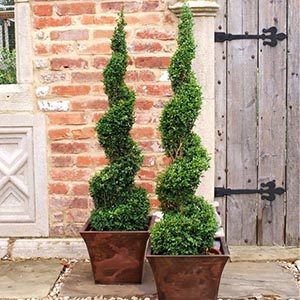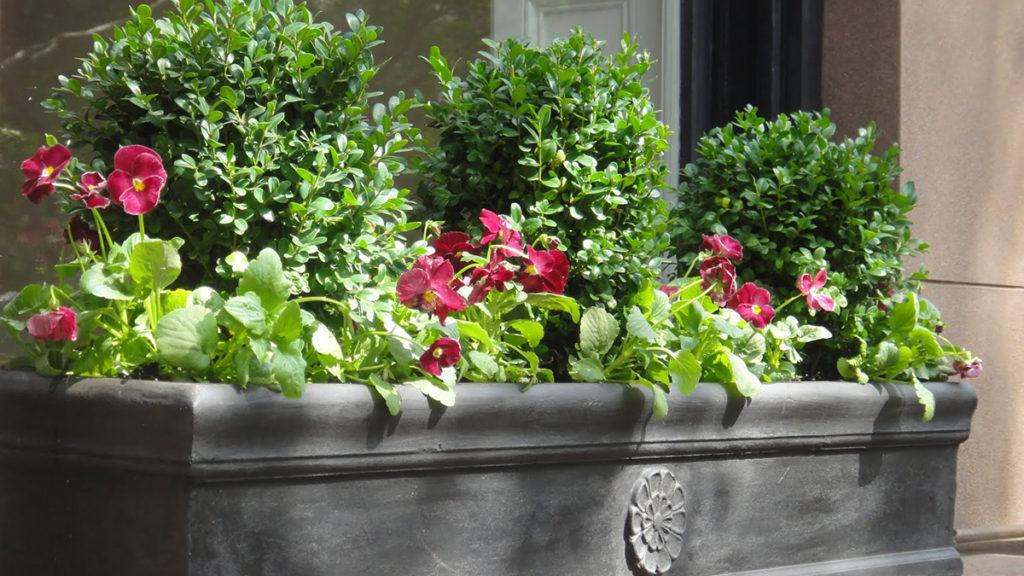Yes, it’s used a lot. And with good reason. Sun, shade, formal, loose, dry, wet, deer resistant, evergreen. The list of reasons why boxwood belongs in gardens goes on and on. Most often used for hedges where it has that old-world English garden effect. Or, sheared into shapes such as orbs and squares. This is a versatile plant that's good for all kinds of uses. Here are four ideas for using boxwood on a smaller scale and in less formal ways. Beginning with this pretty windowbox. Boxwoods (such as Wee Willie® Boxwood) are ideal for window boxes. They require little tending and their dark green leaves complement flowers such as pansies now and heat-lovers later.
Read more here about even more ways to use boxwood in the landscape.

Leggy Plants
Shrubs such as hydrangeas, roses, nandinas, etc. often have bare knees that look better covered up. A tidy boxwood hedge is an easy, evergreen solution. Choose a variety that stays compact with minimal shearing such as Gordo™ Big Leaf Boxwood.

Informal Luxe
There’s no rule that says you have to prune boxwood into tight shapes! Left to grow with just a bit of snipping to get a general shape (this is Chicagoland Green® Boxwood). It’s a lovely, unfussy evergreen shrub that adds color to a landscape.

Classical Nod
We love a full-on fantasy of sheared balls and patterns. However, you can get a bit of the same idea with just a pair of potted or planted boxwood topiary. Once trained, these require minimal shaping. Try naturally narrow Green Tower® Boxwood.

Rule of Three
Things in threes are the most pleasing to the eye. Coat this gate in a boxwood-inspired green and add a pair of sheared boxwood balls. Then you'll get a look that's finished, but not fancy. A taller type such as Green Beauty Boxwood adds the right scale.
Keeping Boxwood Happy
Provide excellent drainage: Boxwood is highly adaptable to various soil types. This includes average or poor soils as well as acidic or alkaline provided the soil is well-drained. Boxwoods can’t take standing water and heavy, wet soil which can lead to root rot. Prevent by amending soil with lots of organic matter and planting high when installing.
Keep it clean: Prune back all dying branches to healthy wood. Remove all debris from the center of the plant. And, thin out some of the outside growth so that air and light can reach the center.
Exposure: Boxwoods thrive in full sun or light shade, but they don’t like exposed, very windy sites, particularly in winter. Protect by watering as needed in late fall. Apply a fresh layer of mulch in fall to help prevent winter damage.
Fertilizing and watering: Apply a balanced, all-purpose fertilizer (10-10-10) in spring. This will encourage leafy growth and again in fall to promote root growth. Monthly application of compost tea and use of drip irrigation, which might mitigate blight..
Back from the brink: If you have a younger, smaller boxwood that's not doing well, prune back the dead branches. Open up the center of the plant and sprinkle one or two cups of a slow-release fertilizer around the shrub. Lastly, water it in. If your plant is older, one of the slower-growing varieties, or taller than 3 feet. The time to recover makes trying to save it impractical. Replace it with a new one.
Image Credits:
Top: Flosgardens; Upper Left: original source unknown; Upper Right: monrovia.com; Lower Left: toparius; Lower Right: original source unknown.
Paint on gate: Benjamin Moore Black Forest Green / BM RME-46





Please login to comment.
Don't have an account?
Sign Up for free